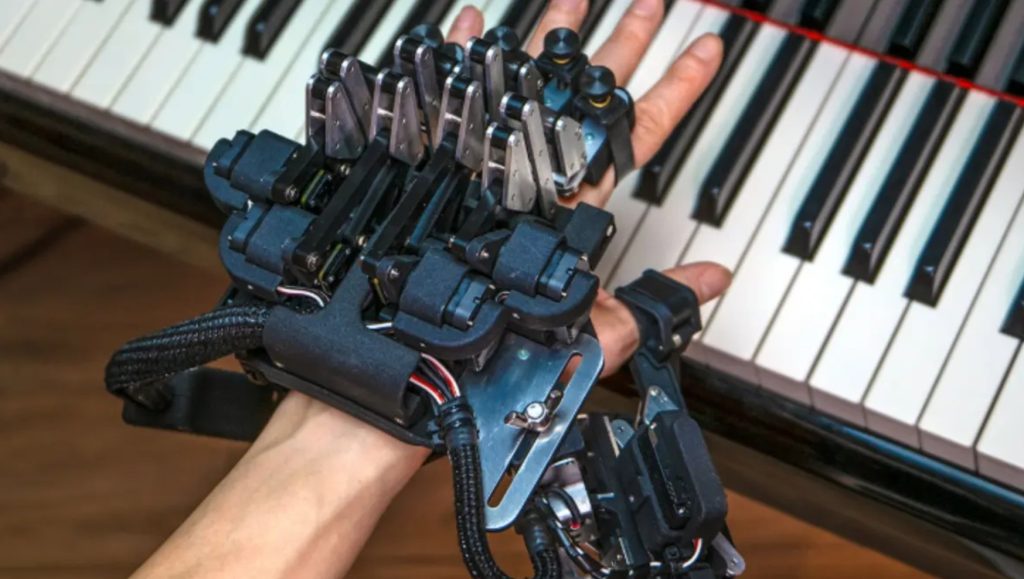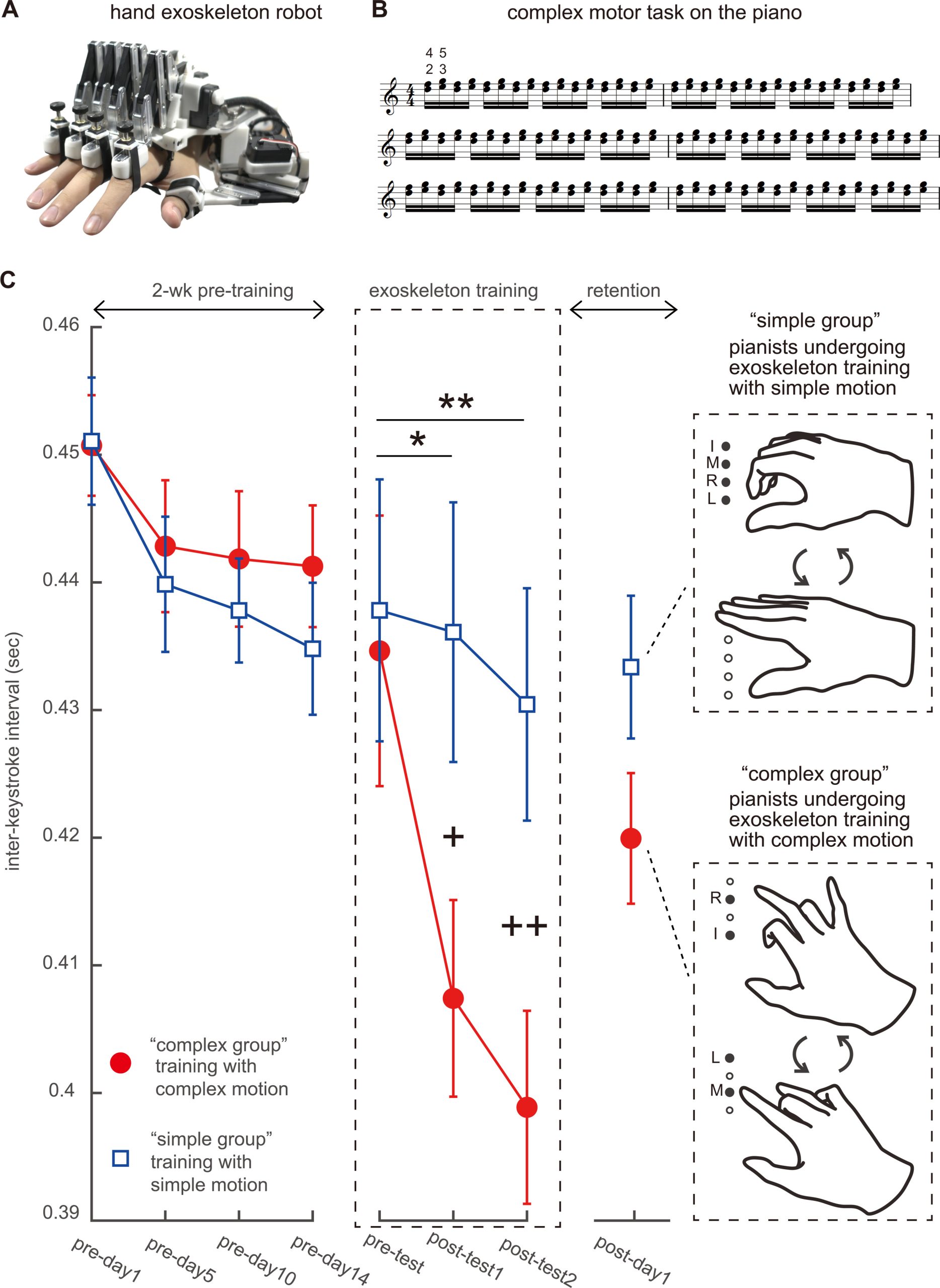When Practice Stagnates: Robotic Training for Pianists
“Practice makes perfect” is a common mantra for any pianist, but we all know it’s an oversimplification. While practice often leads to improvement, true perfection is elusive.
But according to recent research, a robotic exoskeleton hand could help pianists improve their speed of performing difficult pianistic patterns, by overcoming the well-known “ceiling effect”.

Both professional pianists and piano students of all levels often encounter a “hit the roof” or “ceiling effect,” where further practice yields diminishing, none or even negative returns. The 19th century virtuoso training movement with Czerny, Hanon and others along with Schumann’s infamous stretching devices gives proof of the profession’s aim to expand the possible limits. Subsequently, this raises questions about the limitations of traditional training methods in cases when increased training volume may not be enough to overcome these plateaus.
In the field of sports, cutting-edge training methods utilizing technology have been put into practical use and many top athletes are taking advantage of them. Research about sprint running has shown clear benefits of over-speed training. As an opposite of the more common resistance training, it can for example consist of running downhill in high speed to improve the maximum sprint speed.
However, much of the existing research has dealt with simple tasks, leaving a gap in our understanding of how to break through plateaus in complex skills such as piano playing.
Passive training, employing technologies like robotic exoskeletons, may address this by introducing novel movement patterns and enhancing precision and coordination, according to researchers at the NeuroPiano Institute.
“I’m a pianist, but I injured my hand because of overpracticing,” says co-author Shinichi Furuya of Kabushiki Keisha Sony Computer Science: “I was suffering from this dilemma, between overpracticing and the prevention of the injury, so then I thought, I have to think about some way to improve my skills without practicing.” Recalling that his former teachers used to place their hands over his to show him how to play more advanced pieces, he wondered if he could achieve the same effect with a robotic hand.”
They have now tried a new type of robotic hand to help breaking through a pianist’s speed barrier. Unlike previous exoskeletons primarily used for rehabilitation or simple tasks, this device focused on facilitating highly skilled, rapid movements is capable of independently moving each finger, mimicking a pianists complex finger movements.
The exoskeleton device has showed promising results by passively training pianists, guiding their fingers through complex movements and at high speeds that would be impossible to achieve on their own.
This short demo video illustrates the concept:
The study provides evidence that this training stimulates the brain’s ability to adapt and learn (neuroplasticity). This innovative technology has the potential to revolutionize both musical performance and the rehabilitation of conditions that affect hand movement. Surprisingly, this training not only improves the hand directly controlled by the exoskeleton but also enhances the performance of the untrained hand.
Join Piano Street today!
Enjoy reading this article? Get instant unlimited access to aricles, news, sheet music and more in Piano Street’s treasure trove of classical piano music with a membership.
Beyond Human Limits
In a series of experiments involving 118 pianists, participants practiced a challenging chord trill. After weeks of practice, they underwent passive training with the exoskeleton, which performed the trill faster than the pianists themselves could.
The results were remarkable. Even after plateauing with traditional practice, passive training with the exoskeleton significantly improved the pianists’ speed and accuracy. Surprisingly, the untrained hand also showed improved performance, demonstrating an “inter-manual transfer effect.”

Neuroplasticity in Action
Further analysis revealed that the exoskeleton training induced changes in the brain’s motor cortex, suggesting neuroplasticity at play. While the exact mechanisms behind this inter-manual transfer effect require further investigation, the study highlights the potential of robotic augmentation to push the boundaries of human motor skills.
Limitations and Future Directions
The researchers acknowledge limitations, such as potential muscular fatigue during intensive training. However, they believe their findings have significant implications for both musicians and individuals with neurological disorders affecting manual dexterity.
This study underscores the power of technology to enhance human performance and offers a promising avenue for overcoming limitations that have long hindered skilled musicians.
Read the study here:
Surmounting the ceiling effect of motor expertise by novel sensory experience with a hand exoskeleton
Shinichi Furuya et al, Science Robotics (2025). DOI: 10.1126/scirobotics.adn3802
Join Piano Street today!
Enjoy reading this article? Get instant unlimited access to aricles, news, sheet music and more in Piano Street’s treasure trove of classical piano music with a membership.

Comments
Poor Robert Schumann who injured his hand would have liked to have seen this I’m sure.
I’m in the waiting line to borrow one…
Where are the videos of the actual improvement that’s being touted? The one I see shows the pianist playing only slightly faster than the first time but unevenly. It’s an interesting and exciting concept but I will remain skeptical until proof is provided. Best and easiest advice is: strengthen your 4th finger:)
I will love to acquire more fasteners moving in my hands